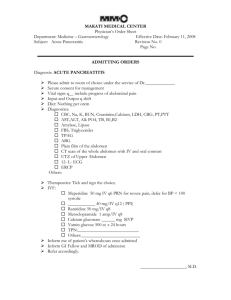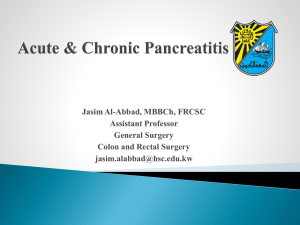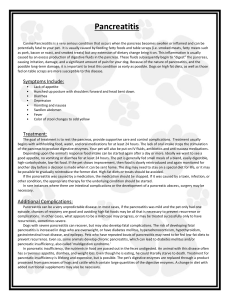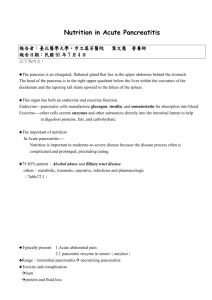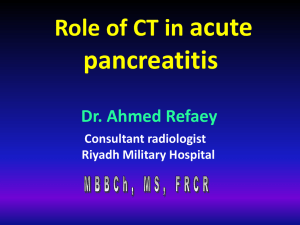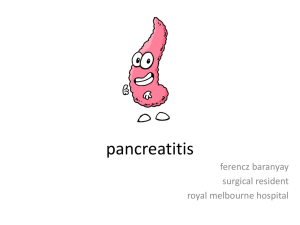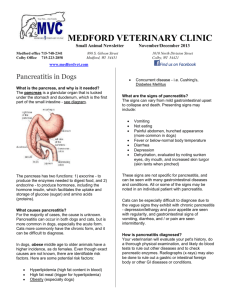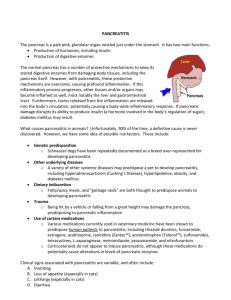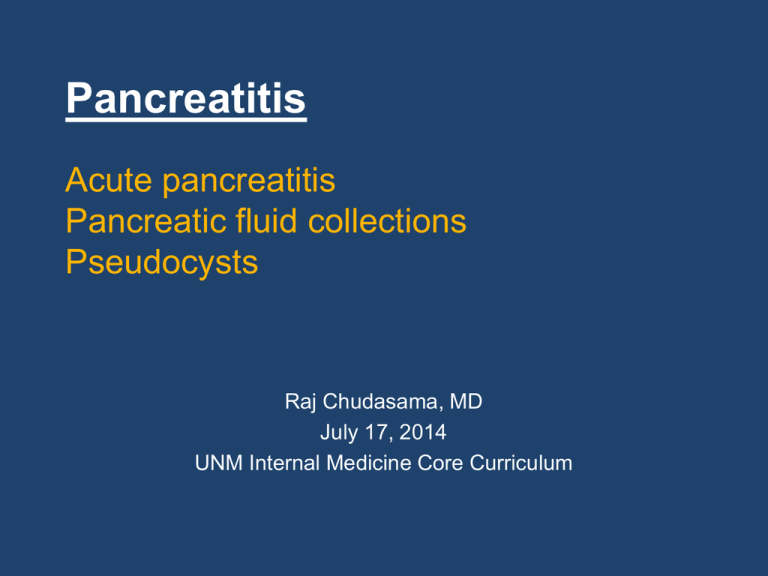
Pancreatitis
Acute pancreatitis
Pancreatic fluid collections
Pseudocysts
Raj Chudasama, MD
July 17, 2014
UNM Internal Medicine Core Curriculum
Outline
• Acute pancreatitis
–
–
–
–
–
–
–
–
Definition
Diagnosis
Determining etiology
Predicting severity
Time course
Necrotizing pancreatitis
Fluid collections
Management pearls
• Pseudocysts
Acute pancreatitis resources
• American College of Gastroenterology Guideline:
Management of Acute Pancreatitis.
– Tenner, Am J Gastro 2013
• Classification of acute pancreatitis—2012: revision
of the Atlanta classification and definitions by
international consensus.
– Banks, Gut 2013
• IAP/APA evidence-based guidelines for the
management of acute pancreatitis.
– Pancreatology 2013
Acute Pancreatitis - Definition
• Defined by at least the first two of three
features:
– Abdominal pain suggestive of pancreatitis
– Serum amylase and/or lipase levels > 3x
greater than upper limit of normal
– Characteristic findings on CT, MRI, or US.
The Revised Atlanta Classification of Acute Pancreatitis
2012
Acute Pancreatitis - Diagnosis
• Serum Amylase
– 40% pancreas
– Sensitivity: 45-85%
– Specificity: 91-99%
• Serum Lipase
– ~100% pancreas
– Sensitivity: 55-100%
– Specificity: 96%
AGA Institute Technical Review on Acute Pancreatitis.
Gastroenterology 2007; 132:2022-2044
Inciting Event
• Gallstones
(45%)
• Alcohol (35%)
• Other (10%)
• Idiopathic
(10%)
Pandol et al. Gastroenterology 2007;132:11271151
Acute Pancreatitis - Imaging
• Transabdominal ultrasonography
– Primary role to identify gallstones or ductal dilation
– Sensitivity to detect stones is ~ 70%
• Contrast enhanced CT scan or MRI
– Reserved for patients
• with unclear diagnosis
• Confirmation of severe acute pancreatitis
• Who fail to improve clinically with initial management
– Optimal timing is 72-96h after presentation
– 15-30% of patients with mild pancreatitis will have
normal CT scan
Determining the etiology
• Transabdominal US should be performed
on all patients
• Check TG (>1000 is significant) if no
gallstones or alcohol use.
• In patient > 40 yr, always consider tumor
• Refer idiopathic pancreatitis to specialist
• Consider genetic testing on pt < 30 yr if
family history of pancreatitis and no other
cause found after 2nd attack
Predicting severe AP
• Severity scoring systems
– Cumbersome
– Require 48h to become accurate
– Severe disease usually obvious regardless
of score
• CT/MRI not reliable in first 24-48h
• CRP takes 72h to become accurate
Predicting severe AP
• Instead, consider
–
–
–
–
–
Early fluid losses
Hypovolemic shock
Organ dysfunction
Patient-specific risk-factors
SIRS
• Heart Rate >90 beats/min
• Temperature >38°C or <36°C
• Respiratory status
– RR >20 breaths/min or
– PaCO2 < 32mmHg
• WBC Count
– >12,000 cells/ul or
– <4,000 cells/ul or
– >10% band forms
Clinical findings associated with
severe pancreatitis
• Patient characteristics
– Age >55
– Obesity (BMI >30 kg/m2)
– Comorbid disease
• SIRS
• Laboratory findings of hypovolemia
– BUN >20 mg/dl, rising BUN
– Hct >44%, rising Hct
– Elevated Cr
• Radiology findings
– Pleural effusions
– Pulmonary infiltrates
– Multiple or extensive extrapancreatic collections
Classification of severity of
pancreatitis
• Mild acute pancreatitis
• Moderately severe acute pancreatitis
• Severe acute pancreatitis
Severity of pancreatitis
• Mild acute pancreatitis
– No organ failure
– No local complications
– By 48h most patients have substantially
improved and begun eating
– Usually require only brief hospitalization
Severity of pancreatitis
• Moderately severe acute pancreatitis
– Local complications
– Only transient organ failure
• Severe acute pancreatitis
– Revision of criteria in 2013
– Persistent organ failure >48h
• By Modified Marshal Score or
• 1993 Atlanta criteria
–
–
–
–
GI bleeding (>500cc/24h)
Shock – SBP < 90 mm Hg
Pa0 2 <60%
Creatinine >2 mg/dl
Organ Failure
• Score of 2 or more for one of the organ
systems using the modified Marshall
scoring system.
The Revised Atlanta Classification of Acute Pancreatitis 2012
Acute Pancreatitis – Natural History
• Early phase
– Occurs within the 7 days of onset of disease
– Changes in the pancreas progress from early
inflammation with peripancreatic edema and
ischemia to resolution or permanent necrosis.
– Severity is based on clinical parameters
• Determined primarily by presence or absence of
organ failure
• More than half of the cases of organ failure occur
in the 1st week of admission
Banks et al. Gut 2013
Acute Pancreatitis – Natural History
• Late phase
– Defined morphologically on the basis of CT
findings
– Begins after the 1st week, and can extend for
weeks to months
– Characterized by persistence of systemic
signs of inflammation or
– Presence of local complications like
increasing necrosis, infection and persistent
multi-organ failure
Banks et al. Gut 2013
Timeline
0h
Clinical picture
SIRS
Labs
Risk factors
24h
Clinical picture
BUN
Hct
SIRS
Organ failure
48h
Clinical picture
APACHE II
Ranson criteria
BISAP
72h
Clinical picture
CT imaging
Early Acute Pancreatitis
Interstitial
Edematous
Pancreatitis
Necrotizing
Pancreatitis
Parenchymal
necrosis
Sterile
Infected
Peripancreatic
necrosis
Sterile
Infected
Parenchymal and
peripancreatic
necrosis
Sterile Infected
• Interstitial pancreatitis
– Pancreatic edema in the absence of necrosis
• Necrotizing pancreatitis
– Diffuse or focal areas of non-viable pancreatic
parenchyma >3cm in size or >30% of
pancreas
– Sterile necrosis at equal risk for organ failure
as infected necrosis
Interstitial edematous pancreatitis
• Localized or diffuse
enlargement of the pancreas
• Homogenous enhancement of
the pancreatic parenchyma
• Peripancreatic and
retroperitoneal tissue usually
normal
• Peripancreatic fat stranding
(arrows)
Copyright © BMJ Publishing Group Ltd & British Society of Gastroenterology. All rights reserved.
Banks P A et al. Gut 2013;62:102-111
Necrotizing Pancreatitis (NP)
• Lack of enhancement of pancreatic
parenchyma after IV contrast
• Occurs in ~20% of patients with AP
• Mortality is ~ 15% in patients with NP, and
up to 30% in those with infected necrosis
• Infected necrosis is the most severe
infectious complication in NP
• Intervention may be required for patients
with infected necrosis
Necrotizing Pancreatitis
Parenchymal necrosis
– Seen in fewer than 5%
of cases
– In the 1st week, CT
shows necrosis as a
more homogenous
nonenhancing area,
and later, a more
heterogeneous area
The Revised Atlanta Classification of Acute Pancreatitis
Necrotizing Pancreatitis
Peripancreatic necrosis
• Seen in ~ 20% of cases
• Heterogeneous areas of
nonenhancement are
visualized with
nonliquefied components
• Commonly located in the
retroperitoneum and
lesser sac
• Better prognosis than
parenchymal necrosis
The Revised Atlanta Classification of Acute Pancreatitis
Necrotizing Pancreatitis
Parenchymal necrosis with
peripancreatic necrosis
• Seen in ~ 75-80% of
cases most common
• Peripancreatic necrosis
associated with full
necrosis of the pancreatic
parenchyma may be
connected to the main
pancreatic duct.
Infected necrosis
• Acute necrotic collection (white arrows
pointing at the borders of the ANC)
• Gas bubbles (white arrowheads), a
pathognomonic sign of infected necrosis
Copyright © BMJ Publishing Group Ltd & British Society of Gastroenterology. All rights reserved.
• Incidence in patients with
NP is ~ 30%
• Peak incidence at 2 – 4 w
• Mortality ~ 12-40%
• Consider it when there is
persistent sepsis, new-onset
sepsis or clinical
deterioration
• Pathognomonic sign is
impacted peripancreatic or
intrapancreatic gas bubbles
in a collection on CT
• Can be proven by culture or
gram stain of tissue/fluid
Banks P A et al. Gut 2013;62:102-111
Infected Necrosis
• FNA for culture can be performed for
diagnosis but no longer first line
– Infected necrosis no longer an immediate
indication for invasive intervention
– Intervention is usually delayed to 4 weeks after
onset of disease
– Treatment dictated by clinical deterioration and/or
imaging, rather than positive FNA culture
– Consider FNA if suspicious for fungal
superinfection that is not responding to therapy
Acute Pancreatitis timeline
Interstitial
Edematous
Pancreatitis
Acute
Peripancreatic
Fluid Collection
Pseudocyst
Necrotizing
Pancreatitis
Acute Necrotic
Collection
Walled Off
Necrosis
Acute
Pancreatitis
0
Time (weeks)
4
Pancreatic and peripancreatic fluid
collections in AP
• Acute peripancreatic fluid collection (APFC)
– No defined wall, homogeneous, resolve
spontaneously
• Pseudocyst
– Well defined wall, no solid material
• Acute necrotic fluid collection (ANC)
– Contains variable amounts of fluid and necrotic tissue
– May be associated with disruption of the PD
• Walled-off necrosis (WON)
– Mature, encapsulated collection of pancreatic and/or
peripancreatic necrosis with a well defined
inflammatory wall
Zaheer et al. Abdominal Imaging. 2012
Acute peripancreatic fluid collection (APFC)
• APFC in the left anterior
pararenal space (white
arrows showing the borders)
• Confined by normal
peripancreatic fascial planes
• No defined wall
• Homogeneous
• Resolve spontaneously
• No associated peripancreatic
necrosis.
• Seen within the first 4 weeks
• Adjacent to pancreas (no
intrapancreatic extension)
Banks P A et al. Gut 2013;62:102-111
Copyright © BMJ Publishing Group Ltd & British Society of Gastroenterology. All rights reserved.
Acute necrotic collection (ANC)
• collection containing variable
amounts of both fluid and
necrosis associated with
necrotizing pancreatitis
• Occurs only in the setting of
acute necrotizing pancreatitis
• No definable wall encapsulating
the collection
• Location—intrapancreatic
and/or extrapancreatic
Thin white arrows -- heterogeneous collection in the
region of the neck and body of the pancreas, without
extension in the peripancreatic tissues.
Copyright © BMJ Publishing Group Ltd & British Society of Gastroenterology. All rights reserved. Banks
P A et al. Gut 2013;62:102-111
Pseudocysts
•
•
•
•
•
•
Encapsulated collection of fluid
Well defined inflammatory wall
Usually outside the pancreas with
minimal or no necrosis
4 weeks after onset of interstitial
edematous pancreatitis
Homogeneous fluid density
No non-liquid component
White arrows -- well defined enhancing rim
White stars -- normal enhancing pancreas.
Copyright © BMJ Publishing Group Ltd & British Society of Gastroenterology. All rights reserved.
Banks P A et al. Gut 2013;62:102-111
Walled-off necrosis (WON)
• Mature, encapsulated collection of
pancreatic and/or peripancreatic
necrosis
• Well defined inflammatory wall.
• >4 weeks after onset of
necrotizing pancreatitis.
• Heterogeneous with liquid and
non-liquid density with varying
degrees of loculations (some may
appear homogeneous)
• Well defined wall, that is,
completely encapsulated
• Location—intrapancreatic and/or
extrapancreatic
Clinical case
• 55 yo woman presents with acute gallstone pancreatitis with the CT
showing pancreatic necrosis. She has ongoing pain and nausea
and enteral nutrition is initiated due to inability tolerate oral intake.
She develops fever of 38.9 on day 7. She is hemodynamically
stable with a heart rate of 92, BP 130/74 and O2 sat 98% on RA.
Leukocytosis (WBC=14,000/mm3), normal hepatic function and
BUN/creatinine. Repeat CT scan of abdomen shows non-walled off
pancreatic necrosis and CT guided FNA is performed. Gram stain of
FNA shows gram-negative rods. Which of the following is the most
appropriate management at this point?
– A. Refer the patient for prompt surgical necrosectomy.
– B. Refer the patient to IR for percutaneous drainage.
– C. Initiate therapy with IV imipenem and continue to observe the patient
for signs of organ failure and hemodynamic instability.
– D. Refer the patient for endoscopic transgastric drainage.
– E. Switch the patient’s route of nutrition support to parenteral.
C. Initiate therapy with IV imipenem and continue to observe the patient for
signs of organ failure and hemodynamic instability.
• The patient has infected pancreatic necrosis that
is not well walled off. Importantly, the patient is
hemodynamically stable without organ failure.
• While many patients will eventually need some
type of drainage (surgical, percutaneous or
endoscopic), the current preferred strategy is to
initiate IV antibiotics and delay the drainage
procedure as long as the patient condition is
stable, allowing the necrosis to become organized
(walled off).
Initial management
• Early aggressive intravenous hydration!!!
IV hydration
• Aggressive hydration, 250-500 ml/hr of isotonic
crystalloid solution should be given to all patients
unless significant cardiovascular or renal disease
• Some recommend 5-10 ml/kg/hr
• After resuscitation goals are met, can decrease rate
• Most beneficial in first 12-24h, may have little benefit
after this
• For hypotension or tachycardia, boluses may be
required
• LR is generally preferred
• Reassess fluid requirements every 6h.
• Goal is to decrease BUN
Clinical case
• 65 yo male admitted with severe abdominal pain, fever, nausea and
vomiting. On exam he is febrile, with stable vitals. Upper abdomen
is diffusely tender, with rebound and absent bowel sounds. Left flank
ecchymosis is present. Serum amylase and lipase are elevated.
After aggressive fluid resuscitation, a contrast CT scan on day 2 of
illness demonstrates an edematous pancreas with nonenhancement
of about 30% of the gland and multiple peri-pancreatic fluid
collections. In terms of management, which of the following
statements about nutrition is correct?
– A. TPN and enteral nutrition result in similar metabolic complications.
– B. Nutritional support is indicated in patients with mild pancreatitis to
reduce complications.
– C. TPN is associated with mortality reduction in acute pancreatitis.
– D. Enteral nutrition is the preferred route for nutritional support in
patients with severe acute pancreatitis.
– E. Pancreatic necrosis contraindicates enteral feeding.
Nutrition therapy
• In mild AP, oral feedings can be started
immediately if no nausea/vomiting, and if pain is
improving
• In mild AP, low-fat solid diet appears as safe as a
clear liquid diet
• In severe AP, enteral nutrition recommended to
prevent infectious complications
• Parenteral nutrition should be avoided unless
enteral route not available, not tolerated, or not
meeting caloric requirements
• Nasogastric and nasojejunal feedings appear
comparable
D. Enteral nutrition is the preferred route for nutritional support in patients with
severe acute pancreatitis.
• Patients with mild pancreatitis can be treated with hydration
alone.
• Initial feeding with a low-fat diet is safe and may reduce the
duration of hospitalization compared to clear liquid diet in
patients with mild pancreatitis.
• Multiple studies have demonstrated that enteral feeding is
safe and tolerated in acute pancreatitis.
• Additionally, enteral feeding may preserve gut barrier function
and prevent translocation of bacteria, which are implicated in
pancreatic infections.
• A meta-analysis of the existing literature has demonstrated
improved outcome with enteral feeding compared with
parenteral feeding, with less infectious complications,
reduced cost and better glycemic control.
ERCP in acute pancreatitis
• Patients with AP and cholangitis should
undergo ERCP within 24h
• In biliary pancreatitis without cholangitis,
timing of ERCP unclear
• Screen for choledocholithiasis with MRCP
(or EUS) if suspicion is high
Antibiotics in AP
• Routine use of prophylactic antibiotics in
severe AP is NOT recommended
• Use of antibiotics in sterile necrosis to
prevent infected necrosis is NOT
recommended
• Probiotic prophylaxis is NOT
recommended
Antibiotics in AP
• Infected necrosis
– Suspect in pt with pancreatic necrosis who
deteriorates or fails to improve after 7-10 days
– Empiric antibiotics after blood cultures vs CTguided FNA
– Carbapenems, quinolones and metronidazole
are best
– Routine use of antifungal agents along with
antibiotics not recommended
Infected necrosis
• Routine percutaneous FNA of peripancreatic collections
to detect bacteria is not indicated, because clinical signs
(i.e. persistent fever, increasing inflammatory markers)
and imaging signs (i.e. gas in peripancreatic collections)
are accurate predictors of infected necrosis in the
majority of patients.
• Although the diagnosis of infection can be confirmed by
FNA, there is a risk of false-negative results.
Indications for intervention in
necrotizing pancreatitis:
• 1) Clinical suspicion of, or documented
infected necrotizing pancreatitis with clinical
deterioration, preferably when the necrosis
has become walled-off,
• 2) In the absence of documented infected
necrotizing pancreatitis, ongoing organ failure
for several weeks after the onset of acute
pancreatitis, preferably when the necrosis
has become walled-off.
Indications for intervention in sterile
necrotizing pancreatitis
• 1) Ongoing gastric outlet, intestinal, or biliary obstruction due
to mass effect of walled-off necrosis (i.e. arbitrarily >4-8
weeks after onset of acute pancreatitis)
• 2) Persistent symptoms in patients with walled-off necrosis
without signs of infection (i.e. arbitrarily >8 weeks after onset
of acute pancreatitis)
• 3) Disconnected duct syndrome (i.e. full transection of the
pancreatic duct in the presence of pancreatic necrosis) with
persisting symptomatic (e.g. pain, obstruction) collection(s)
with necrosis without signs of infections (i.e. arbitrarily >8
weeks after onset of acute pancreatitis)
Interventions in AP
• In general, interventions in necrotizing
pancreatitis should be delayed until all
fluid collections have become walled-off,
at least 4 weeks from presentation
The role of surgery
• In mild gallstone pancreatitis, cholecystectomy should
be performed before discharge to prevent recurrence
• In necrotizing biliary AP, cholecystectomy should be
deferred until active inflammation subsides and fluid
collections resolve or stabilize after 6 weeks
• In patients with biliary pancreatitis who have
undergone sphincterotomy and are fit for surgery,
cholecystectomy is advised, because ERCP and
sphincterotomy prevent recurrence of biliary
pancreatitis but not gallstone related gallbladder
disease, i.e. biliary colic and cholecystitis
Role of surgery cont’d
• Asymptomatic pseudocysts or fluid
collections do not require intervention
• In stable infected necrosis, drainage should
be delayed preferably >4 weeks to allow
liquefaction of contents and development of a
wall around the necrosis
• In symptomatic patients with infected
necrosis, minimally invasive methods of
necrosectomy are preferred to open route
Video-Assisted Retroperitoneal
Debridement (VARD)
• Involves using a 5 cm subcostal incision
and limited direct debridement followed by
subsequent video-assisted debridement
• Morbidity and mortality of 24%-54% and
0%-8% respectively
• Usually only requires one session/patient
Freeman et al. Pancreas 2012; 41 (8): 1176-
Van Brunschot S et al. Clin Gastroenterology and
Hepatology 2012; 10:1190-1201
• Management of pseudocysts
Pseudocysts
• Pseudocysts complicate 10-26% of acute
pancreatitis cases
• Also present in 20-40% of chronic pancreatitis
cases
• Most common after acute exacerbations of chronic
pancreatitis
• Usually nonpalpable on physical examination
• Like arise from disruption of main pancreatic duct
or intrapancreatic branches without significant
parenchymal necrosis
• High amylase levels in fluid
Indications for intervention
•
•
•
•
•
•
•
•
Persistent pain
Gastric or duodenal obstruction
Biliary obstruction
Ascites
Pleural effusion
Enlarging size on serial imaging
Evidence of infection or bleeding
Possible pancreatic cystic malignancy
Van Brunschot S et al. Clin Gastroenterology and
Hepatology 2012; 10:1190-1201

